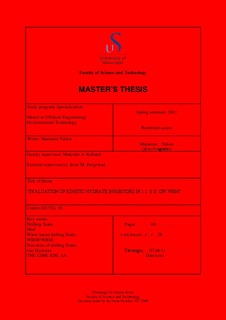| dc.description.abstract | Intention: This thesis is written as a finishing part of my master degree at the University of Stavanger (UiS). The project has been in collaboration with MI-SWACO, A Schlumberger Company, with Irene M. Færgestad as my teaching supervisor in this Company. Malcolm Kelland has been my teaching supervisor at the UiS.
Objectives: This thesis is a project on drilling fluids and gas hydrates linked together with laboratory testing. The project is a large project done for a customer of MI-SWACO, going over several years where this thesis just is a small part of it. The main part for me has been standard laboratory testing of water based drilling fluids, and a smaller part on the gas hydrate testing. The purpose has been to be able to make a good 1.1 s.g. water based drilling fluid with all its qualities intact, which also contains an effective chemical inhibitor to prevent gas hydrate formation, without the inhibitor affecting the drilling fluid negatively.
Methods: A base fluid formulation was made and tested. Further drilling fluids consisting of the base formulation added chemical inhibitors were also made and tested. The drilling fluid tests consisted of: Rheology, pH, API fluid loss, ageing, dispersion and accretion –tests. Based on the results from these tests, some of the drilling fluids were taken to the next level and the gas hydrate test. The gas hydrate testing was performed using a Physica rheometer. The formation of gas hydrates could be seen as an increase in viscosity and decrease in pressure. Also, the melting process was able to be detected by using this equipment.
Results: The drilling fluid test showed that the mud-formulations with best result were formulations 3 and 9. These two had acceptable results throughout the entire testing. Thereby these two, together with formulations 1 and 7 were tested on the Physica gas hydrate test equipment.
Throughout the gas hydrate test, only formulation 7 gave no gas hydrate formation and seemed to be successful. But his was no surprise, since it contained thermodynamic inhibitors known to have a good preventive effect on gas hydrate formation. Unfortunately, none of the other formulations tested had any good results. A lot of gas hydrate was formed and the inhibitors did not seem to work very well.
Conclusion: Based on these tests results, more testing must be performed to reach the goal of creating good water based drilling fluid at 1.1 s.g. for deepwater drilling, with a combination of LDHI and THI inhibitor having a good inhibitive effect on gas hydrate formation. | en_US |
